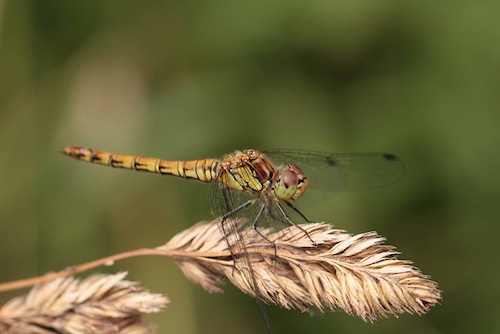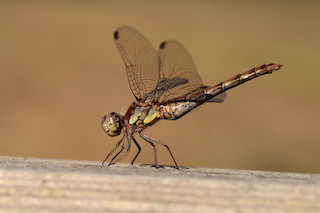 The Common Darter is one of our latest-flying dragonflies: it is on the wing into October, and even November in warmer autumns.
The Common Darter is one of our latest-flying dragonflies: it is on the wing into October, and even November in warmer autumns.
Photo: © Natural England/Paul Lacey
Scientific name: Sympetrum striolatum
Conservation status: Common
What to look for:
- Colouring: The male has a bright orange-red abdomen, while females and juveniles are yellowish-brown, sometimes with red colouring on the segment boundaries. Both sexes have black legs with a distinctive yellow stripe, and yellow patches on the sides of the brown thorax.
- Size: Wingspan c. 58 mm.
- When: Flies from June to November.
- Where: Found by the still water in which it breeds, often perching in vegetation or sometimes on the ground. It will frequently travel some distance from water. It is less abundant in Scotland, but common in the rest of the UK.
- Similar species: Ruddy Darter, the males of which have a more pure-red abdomen, compared to the more orange colouring of the Common Darter. All female Darter species can be confused, so it is worth checking an ID guide in the field.
 The Common Darter is a dragonfly associated with the golden days of high summer and autumn. Often on the wing into November, the red abdomen of the males (photo below) and yellow/russet of the females (photo to right) seem appropriate for the autumn colours of the later part of its flight season. In the southern regions of its Eurasian range, the Common Darter flies throughout the year.
The Common Darter is a dragonfly associated with the golden days of high summer and autumn. Often on the wing into November, the red abdomen of the males (photo below) and yellow/russet of the females (photo to right) seem appropriate for the autumn colours of the later part of its flight season. In the southern regions of its Eurasian range, the Common Darter flies throughout the year.
This dragonfly is highly territorial when guarding its breeding area (ponds, slow-flowing rivers, ditches), but will sometimes hunt for food away from water, when it loses its territorial behaviour, sometimes gathering in fairly large numbers. It will perch prominently on a branch or fence post in a sunny patch before launching (darting – hence its name) after insect prey as it passes, and then returning to the same spot.
Eggs are laid with the male holding the female and swinging her in an arc over the water, in effect guiding the female’s oviposition.
Did you know…?
…Dragonflies do not go through a pupal stage in their development, unlike butterflies. The adult emerges from the final moult of the larval stage, which takes place above the waterbody surface.
…The Highland Darter, native to Scotland, is usually considered a darker (melanistic) form of the Common Darter rather than a separate species. The darker colouring of the Scottish form enhances thermoregulation in the colder conditions.
…Dragonflies used to be much larger. A fossil from 300 million years ago has a wingspan of one metre!
More information and references:
Chinery, M., 2004. Collins Complete Guide to British Insects. Collins, London.
Jones, S., 2010. Insects of Cornwall and the Isles of Scilly. Alison Hodge, Penzance.

Published: September 2014
Author: Amanda Scott
Photos: © Natural England/Paul Lacey
